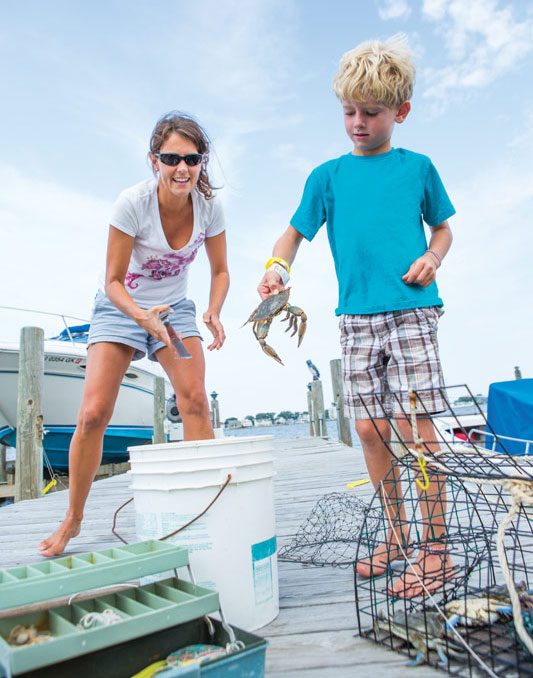
It just might be summer’s best bang for the buck. All you need to go crabbing is a length of string with a hunk of raw chicken neck, fish head or hot dog tied to one end and a small fisherman’s net to scoop up your blue-clawed quarry. Crabbing is a pastime for the entire family; it requires patience rather than skill, and the payoff is a free meal as delicious as it is simple to prepare.
The ocean has all the glamour, but the bay is where you find the Callinectus Sapidus—blue claws. Stand in shallow water, and you may see them skitter by, perhaps stopping to nip your toe. If you’re fast with the net, the last laugh is yours. It’s more common, however, to find crabs loitering at the edge of docks or bulkheads, those often algae-covered retaining walls that separate the water from the land. Bridges are generally not good for crabbing—too much space between you and the water.
Here’s the drill: Drop your baited line and wait for the crab’s keen sense of smell to do the rest. The piece of bait needs to be large enough for the crab to grip it tightly, but not so big that it can’t get its claws around it. When it latches on, swoop down with your long-handled net, or slowly, carefully pull in your line hand over hand until you can get a net underneath it. Grab about two or three per person and, voilà, dinner!
By June the bays have usually warmed up enough that the crabs come out to feed. From late July through October, the crabs are at their biggest and meatiest. The clawed critters favor the semi-saline water known as brackish.
From Raritan Bay and Sandy Hook down to Cape May and the Delaware Bay, you have roughly 83 miles of bay shore to choose from. Popular crabbing spots include the Shrewsbury, Navesink and Metedeconk rivers, Barnegat Bay, Toms River Bay and Little Egg Harbor.
You don’t need a license unless you are using large commercial traps. Stick to public property, don’t trespass, and you’ll be fine. The only other thing to know is that the minimum-size keeper is 4 ½ inches measured from point to point. Crabbers generally throw back females, recognizable by their V-shaped apron, or underside. (Males have a T-shaped apron.) It’s not mandatory unless she’s pregnant. If she is, you’ll see an egg sac, which looks like an orange sponge, under her abdomen. Many crabbers crab purely for the sport of it and throw them all back.
The easiest part is the cooking. Just toss them in boiling water until they turn dark red. The most fun part is the eating. Just go at them with a wooden mallet and your fingers.
